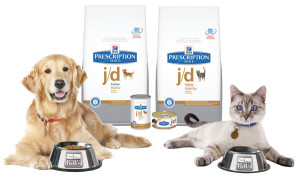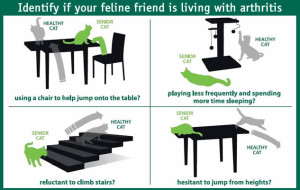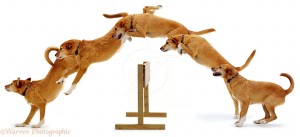
Arthritis is common in dogs and cats but is under-recognised, especially in cats. More than 20% of dogs are affected, but because dogs are much more stoic than we are, and rarely grumble about the pain, many dogs fail to get the relief we could so easily give them. More than 90% of cats have X-ray signs of osteoarthritis but few are treated.
Osteoarthritis, rather than rheumatoid arthritis, is by far the most common form of arthritis we see in pets. It has many causes including growth abnormalities, poor conformation, trauma and obesity.
How can you tell if your pet has arthritis?
Signs range from slowing down towards the end of a walk, stiffness on rising, difficulty or reluctance to jump into the car, some difficulty going up or down stairs, being unable to squat properly to toilet, right through to an obvious lameness in one leg. Cats easily slip under the radar because we don’t take them for walks. They just become less active and sleep more. It is often when they pull themselves up on the couch rather than jumping up that clients may mention it. Arthritis is very advanced by this stage.
The earlier signs are often blamed on ageing. We are so often in denial about arthritic pain in our pets that it is commonplace for clients to tell us as we discuss their hobbling dog “She can’t be in pain because she never cries out”. And we’re thinking “She is shouting in body language that ‘it really hurts when I put weight on that leg’!” It is remarkable how many ‘old’ dogs and cats regain their youth and a zest for life when we relieve the pain of arthritis.
Accurate diagnosis is the foundation for successful treatment.
Please note that the symptoms listed above can be due to many problems other than arthritis. A careful physical exam and sometimes X-rays will usually diagnose the actual cause.
How can Halifax help my pet? The 10 point plan.
There is no cure for arthritis in dogs and cats but nearly all pets can get very significant improvement in their quality and enjoyment of life using one or more modalities from our 10 point plan:
1. Weight management. Keeping cats and dogs lean throughout life dramatically reduces the incidence of arthritis. It is not just the extra wear and tear of carrying more weight. Fat produces a slew of inflammatory chemicals that promote inflammation throughout the body, including in joints. Even after pets have developed osteoarthritis weight reduction reduces the signs of arthritis and often means easier control of pain.
2. Exercise management is a powerful tool for dogs. This doesn’t always mean less exercise, but rather avoiding impactive exercise like stick-chasing, running and jumping. Having 2-4 shorter walks rather than one longer walk is helpful. For cats a ramp or footstool to get up on a bed or the sofa can make a huge difference.

4. Non-steroidal anti-inflammatory drugs (NSAIDs) are the mainstay of treatment for arthritis in human medicine. They have two big benefits. They give prompt relief from pain, and the suppression of inflammation helps block the vicious cycle whereby inflammatory enzymes and chemicals break down the protective cartilage in joints as well as the lubricant proteins in joint fluid. The last twenty years have seen a breakthrough in this area of treatment for pets. Dogs, and especially cats, cannot tolerate most of the NSAIDs used to treat humans, often developing life-threatening gastrointestinal or kidney problems. Now that has changed and there are four NSAIDs that are very safe to use long term in dogs, and just one in cats. We often use NSAIDs as a short treatment trial to assess the level of arthritic pain a pet is suffering. So many supposedly ‘old’ pets promptly regain such a zest for life that their owners can see the value in treating the arthritis.
5. Pentosan polysulphate is normally given as a course of four injections, a week apart, under the skin. It has several beneficial effects in arthritic joints, mainly in settling down inflammation and improving the lubricating quality of the joint fluid.
6. Physiotherapy can help. Joint pain often results in the tightening of muscles around the joint and most pets appreciate gentle massage of the muscles above and below the joint. A good thing to do while watching TV. After a period of massage try flexing and extending the joint through its full range of motion. Using a wheat bag or hottie to warm up the muscles before you start is helpful.

Comfy bed helps with arthritis
7. A warm, well-padded bed helps most arthritis sufferers. In particular getting dogs up off the floor pays dividends.
8. Nutraceuticals is the name given to those dietary supplements which can relieve signs of illness. There is quite a long list of nutraceuticals credited with easing joint discomfort and we have prescribed many over the years. Vitamin E, selenium, MSM, deer velvet, green lipped mussel extract, glucosamine, chondroitin, shark cartilage, omega 3 fatty acids – the list goes on. The reported results are highly variable. How come? Firstly, we all believe what we want to believe, so the placebo effect is seen in pet treatment too. Secondly, there is a lot of variation in the quality of nutraceuticals sold. Thirdly, some nutraceuticals work best in synergy with others. When properly designed studies have been done there is support for Omega 3 fatty acids, green lipped muscle extract and just one glucosamine/chondroitin formulation.
9. Surgery. This is the answer for a few specific joint problems. In particular, ruptured knee ligaments, especially with meniscal injury, unstable or luxating kneecaps, and the problems of chips breaking off in the joints of rapidly growing young dogs. Joint replacement can also be a last resort when other treatment options are no longer effective. However most osteoarthritis is managed without surgery.
10. Acupuncture can help arthritic joints, most dogs tolerate acupuncture quite well, but it is not for the needle shy!
Seeing your faithful friend moving freely is truly satisfying. If you think your pet has signs of arthritis or is just slowing down, give us a call now.



Recent Comments